Dissertation: COVID-19 Impact on UK Hospitality Sector (Nandos)
VerifiedAdded on 2022/12/05
|49
|14048
|419
Report
AI Summary
This research project investigates the impact of the COVID-19 pandemic on the operations and strategies of Nandos, a prominent fast-food chain operating within the UK hospitality sector. The study employs a comprehensive methodology, including quantitative research, a deductive approach, and a positivism philosophy, utilizing surveys and questionnaires to gather primary and secondary data. The research addresses key objectives such as understanding change management concepts, identifying challenges faced by Nandos, assessing the extent of COVID-19's impact on business operations, and recommending effective strategies for managing change. The literature review explores various change management models, including Lewin's and PDCA, and examines the specific challenges faced by Nandos, such as decreased sales, reduced customer base, and employee turnover. The findings, based on data analysis, provide insights into the effectiveness of different strategies adopted by Nandos to mitigate the negative effects of the pandemic. The conclusion summarizes the research findings, offers recommendations for improvement, and identifies limitations and areas for further study.
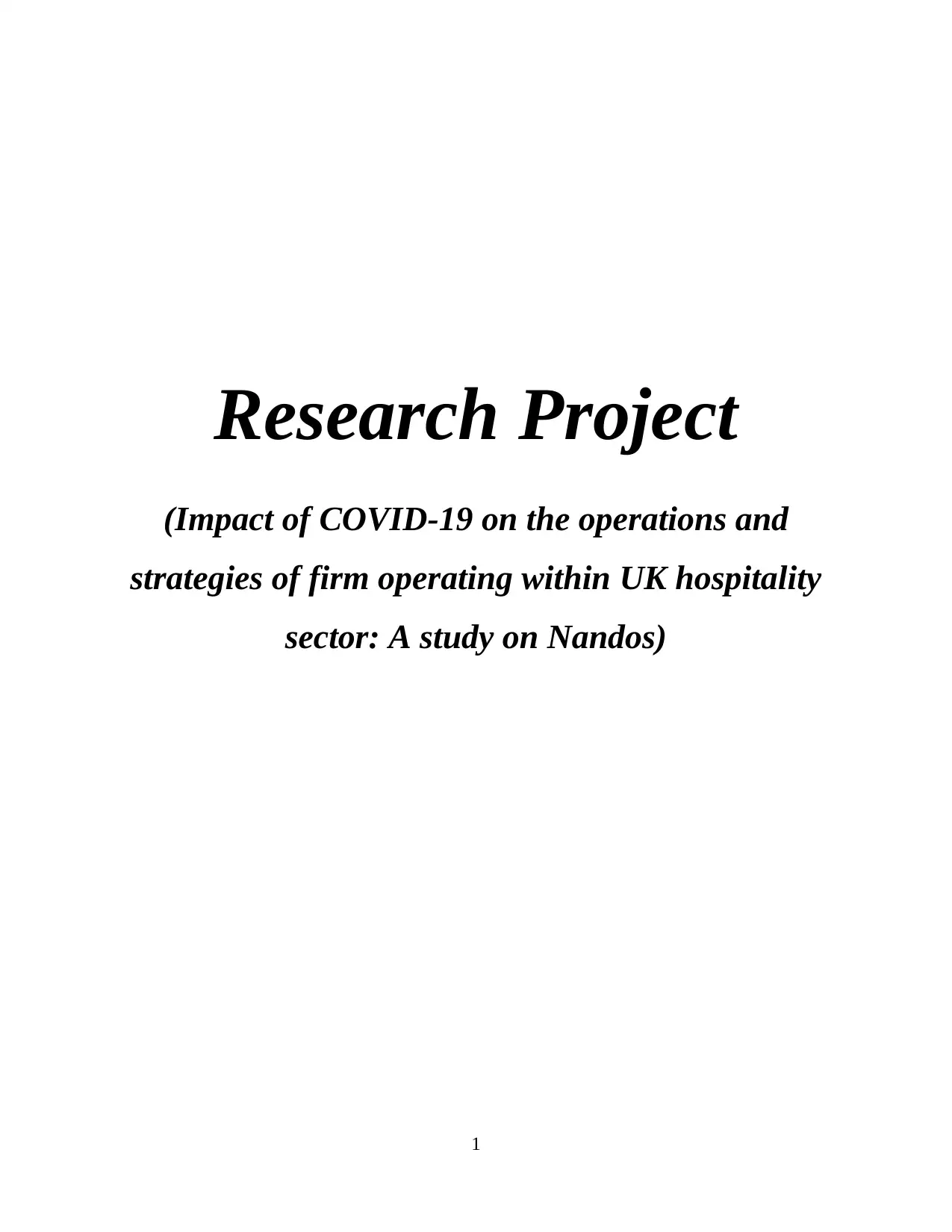
Research Project
(Impact of COVID-19 on the operations and
strategies of firm operating within UK hospitality
sector: A study on Nandos)
1
(Impact of COVID-19 on the operations and
strategies of firm operating within UK hospitality
sector: A study on Nandos)
1
Paraphrase This Document
Need a fresh take? Get an instant paraphrase of this document with our AI Paraphraser
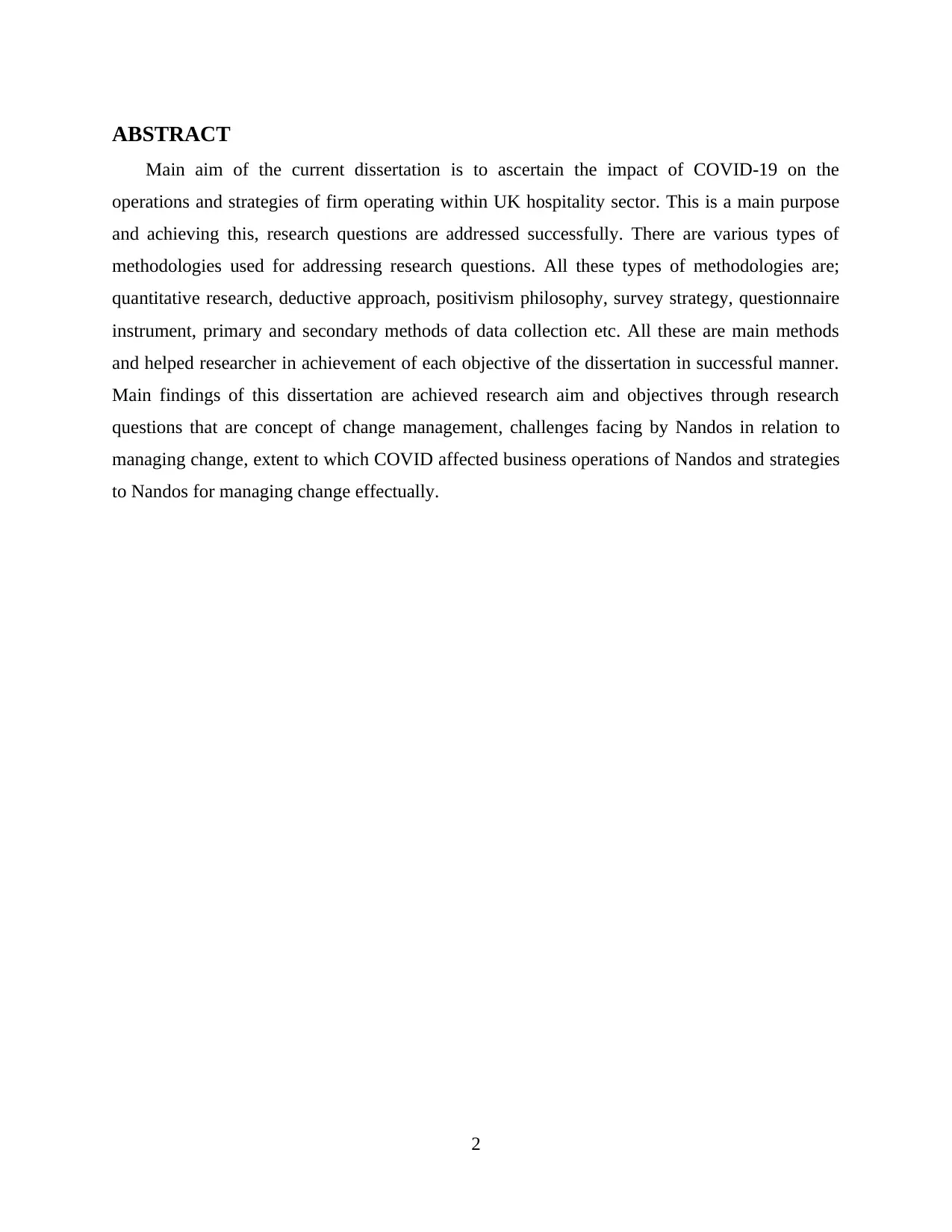
ABSTRACT
Main aim of the current dissertation is to ascertain the impact of COVID-19 on the
operations and strategies of firm operating within UK hospitality sector. This is a main purpose
and achieving this, research questions are addressed successfully. There are various types of
methodologies used for addressing research questions. All these types of methodologies are;
quantitative research, deductive approach, positivism philosophy, survey strategy, questionnaire
instrument, primary and secondary methods of data collection etc. All these are main methods
and helped researcher in achievement of each objective of the dissertation in successful manner.
Main findings of this dissertation are achieved research aim and objectives through research
questions that are concept of change management, challenges facing by Nandos in relation to
managing change, extent to which COVID affected business operations of Nandos and strategies
to Nandos for managing change effectually.
2
Main aim of the current dissertation is to ascertain the impact of COVID-19 on the
operations and strategies of firm operating within UK hospitality sector. This is a main purpose
and achieving this, research questions are addressed successfully. There are various types of
methodologies used for addressing research questions. All these types of methodologies are;
quantitative research, deductive approach, positivism philosophy, survey strategy, questionnaire
instrument, primary and secondary methods of data collection etc. All these are main methods
and helped researcher in achievement of each objective of the dissertation in successful manner.
Main findings of this dissertation are achieved research aim and objectives through research
questions that are concept of change management, challenges facing by Nandos in relation to
managing change, extent to which COVID affected business operations of Nandos and strategies
to Nandos for managing change effectually.
2
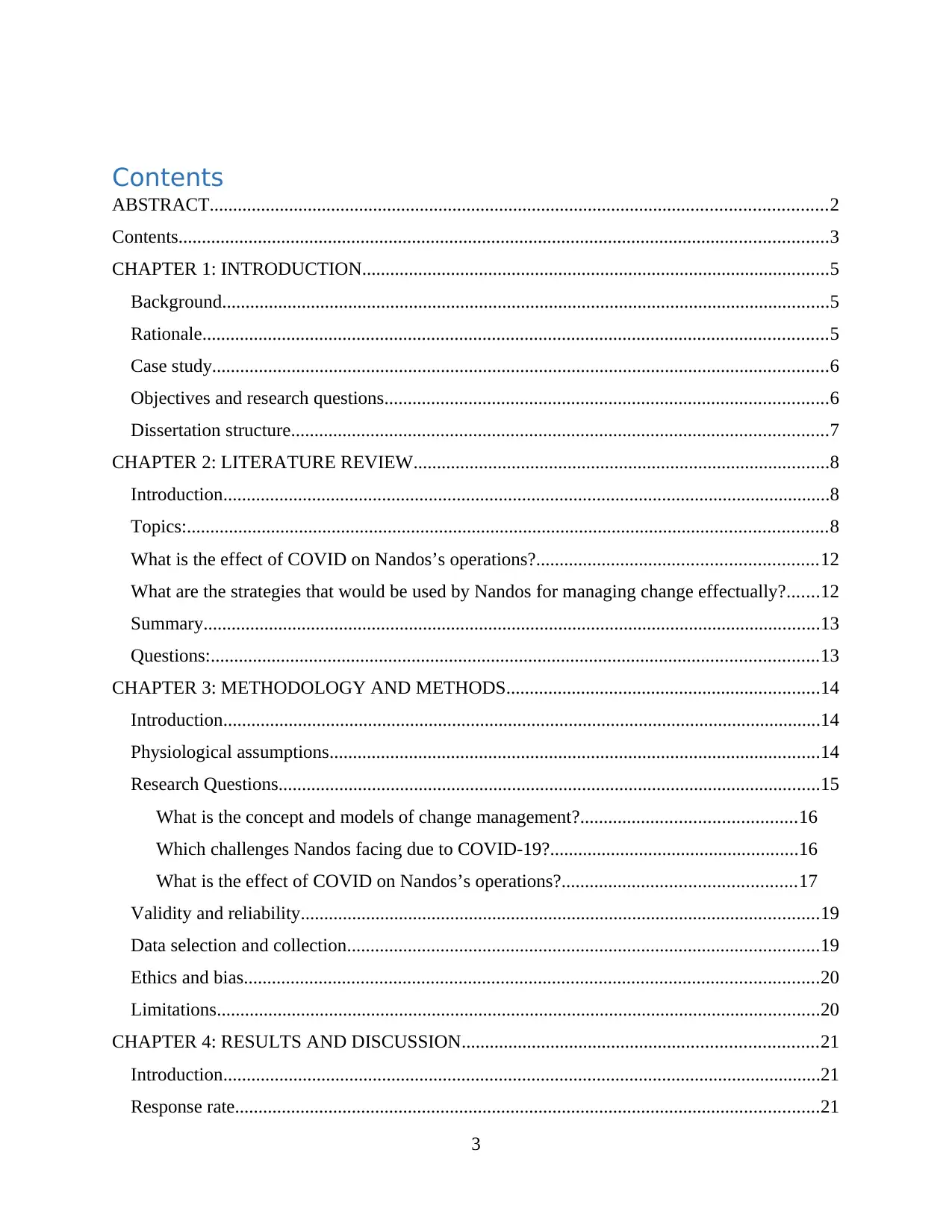
Contents
ABSTRACT....................................................................................................................................2
Contents...........................................................................................................................................3
CHAPTER 1: INTRODUCTION....................................................................................................5
Background..................................................................................................................................5
Rationale......................................................................................................................................5
Case study....................................................................................................................................6
Objectives and research questions...............................................................................................6
Dissertation structure...................................................................................................................7
CHAPTER 2: LITERATURE REVIEW.........................................................................................8
Introduction..................................................................................................................................8
Topics:.........................................................................................................................................8
What is the effect of COVID on Nandos’s operations?............................................................12
What are the strategies that would be used by Nandos for managing change effectually?.......12
Summary....................................................................................................................................13
Questions:..................................................................................................................................13
CHAPTER 3: METHODOLOGY AND METHODS...................................................................14
Introduction................................................................................................................................14
Physiological assumptions.........................................................................................................14
Research Questions....................................................................................................................15
What is the concept and models of change management?..............................................16
Which challenges Nandos facing due to COVID-19?.....................................................16
What is the effect of COVID on Nandos’s operations?..................................................17
Validity and reliability...............................................................................................................19
Data selection and collection.....................................................................................................19
Ethics and bias...........................................................................................................................20
Limitations.................................................................................................................................20
CHAPTER 4: RESULTS AND DISCUSSION............................................................................21
Introduction................................................................................................................................21
Response rate.............................................................................................................................21
3
ABSTRACT....................................................................................................................................2
Contents...........................................................................................................................................3
CHAPTER 1: INTRODUCTION....................................................................................................5
Background..................................................................................................................................5
Rationale......................................................................................................................................5
Case study....................................................................................................................................6
Objectives and research questions...............................................................................................6
Dissertation structure...................................................................................................................7
CHAPTER 2: LITERATURE REVIEW.........................................................................................8
Introduction..................................................................................................................................8
Topics:.........................................................................................................................................8
What is the effect of COVID on Nandos’s operations?............................................................12
What are the strategies that would be used by Nandos for managing change effectually?.......12
Summary....................................................................................................................................13
Questions:..................................................................................................................................13
CHAPTER 3: METHODOLOGY AND METHODS...................................................................14
Introduction................................................................................................................................14
Physiological assumptions.........................................................................................................14
Research Questions....................................................................................................................15
What is the concept and models of change management?..............................................16
Which challenges Nandos facing due to COVID-19?.....................................................16
What is the effect of COVID on Nandos’s operations?..................................................17
Validity and reliability...............................................................................................................19
Data selection and collection.....................................................................................................19
Ethics and bias...........................................................................................................................20
Limitations.................................................................................................................................20
CHAPTER 4: RESULTS AND DISCUSSION............................................................................21
Introduction................................................................................................................................21
Response rate.............................................................................................................................21
3
⊘ This is a preview!⊘
Do you want full access?
Subscribe today to unlock all pages.

Trusted by 1+ million students worldwide
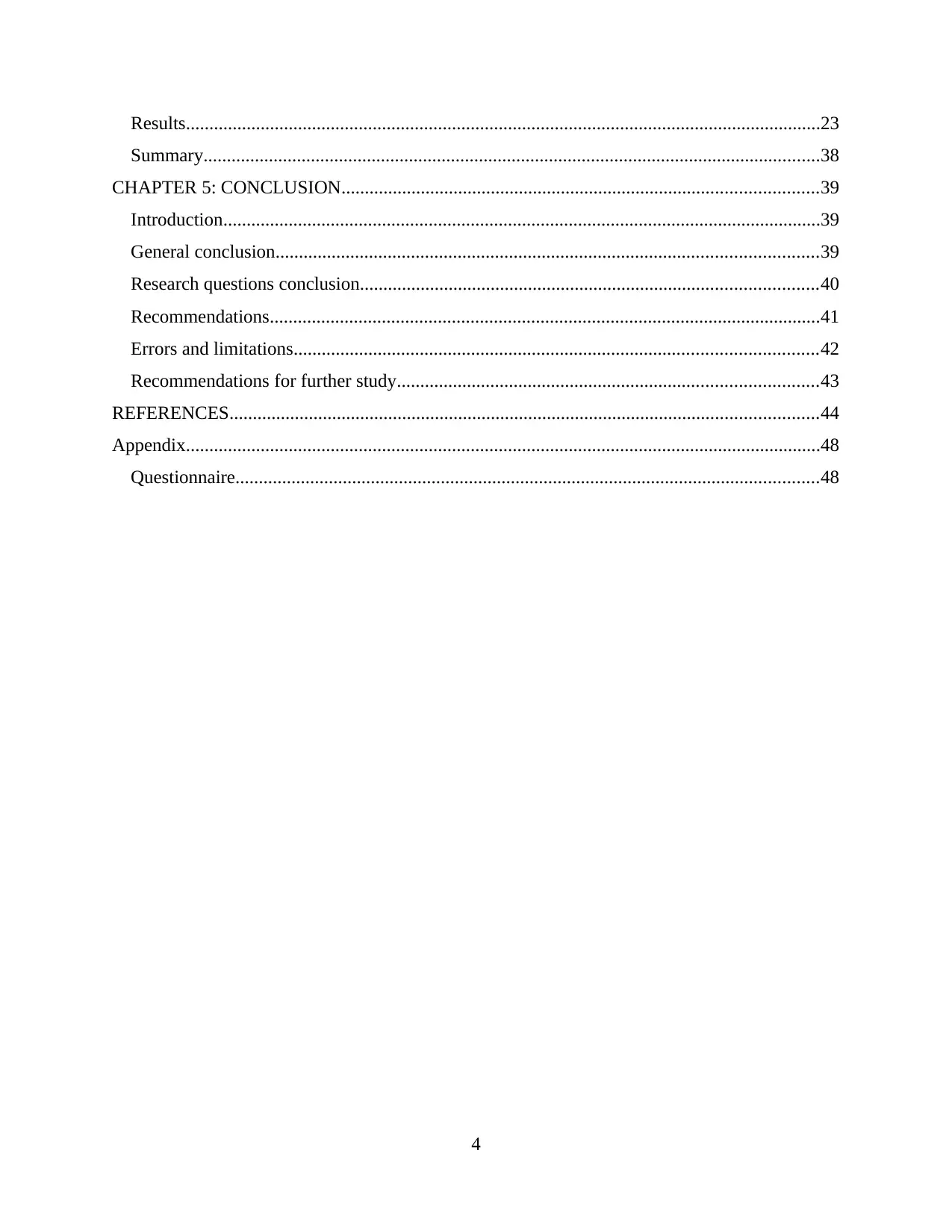
Results........................................................................................................................................23
Summary....................................................................................................................................38
CHAPTER 5: CONCLUSION......................................................................................................39
Introduction................................................................................................................................39
General conclusion....................................................................................................................39
Research questions conclusion..................................................................................................40
Recommendations......................................................................................................................41
Errors and limitations................................................................................................................42
Recommendations for further study..........................................................................................43
REFERENCES..............................................................................................................................44
Appendix........................................................................................................................................48
Questionnaire.............................................................................................................................48
4
Summary....................................................................................................................................38
CHAPTER 5: CONCLUSION......................................................................................................39
Introduction................................................................................................................................39
General conclusion....................................................................................................................39
Research questions conclusion..................................................................................................40
Recommendations......................................................................................................................41
Errors and limitations................................................................................................................42
Recommendations for further study..........................................................................................43
REFERENCES..............................................................................................................................44
Appendix........................................................................................................................................48
Questionnaire.............................................................................................................................48
4
Paraphrase This Document
Need a fresh take? Get an instant paraphrase of this document with our AI Paraphraser
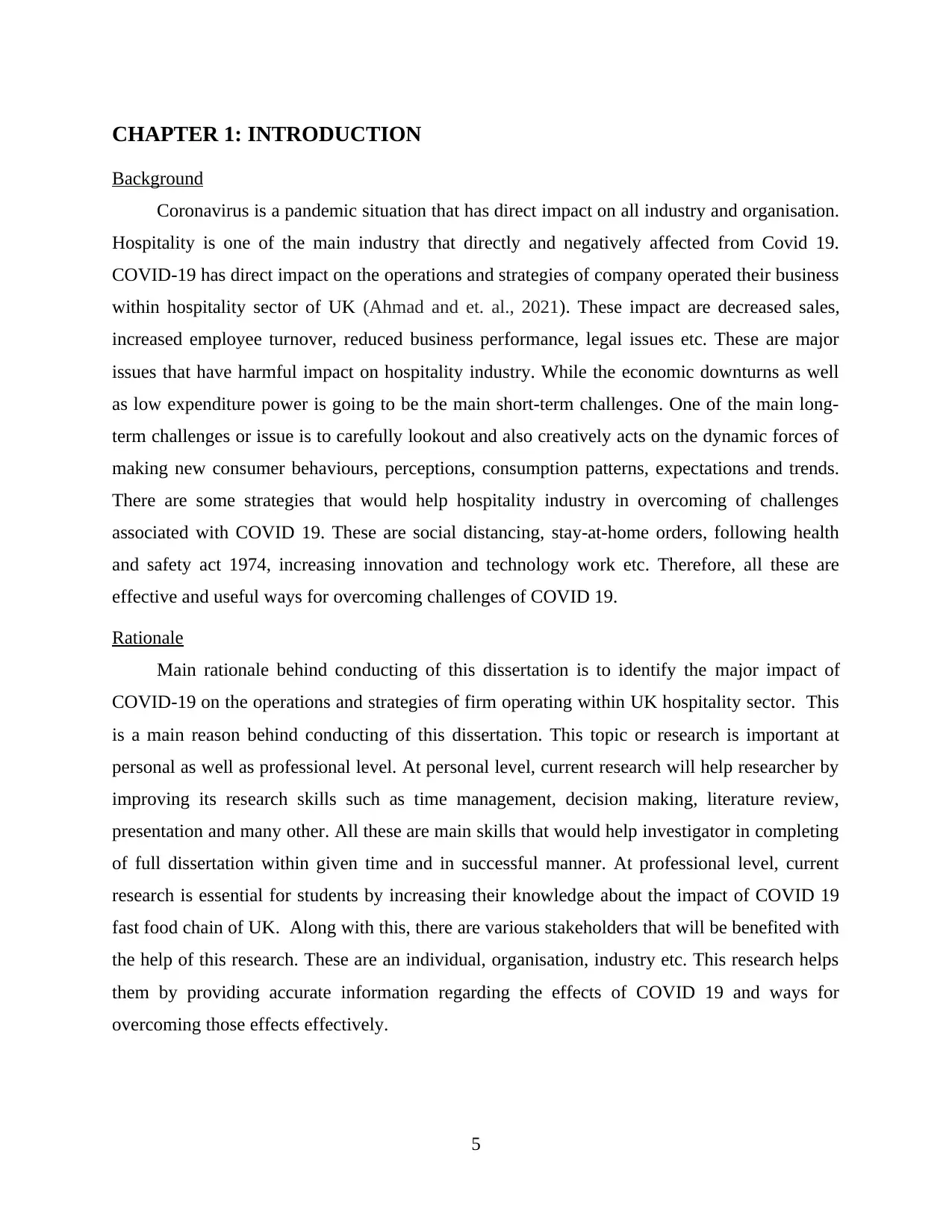
CHAPTER 1: INTRODUCTION
Background
Coronavirus is a pandemic situation that has direct impact on all industry and organisation.
Hospitality is one of the main industry that directly and negatively affected from Covid 19.
COVID-19 has direct impact on the operations and strategies of company operated their business
within hospitality sector of UK (Ahmad and et. al., 2021). These impact are decreased sales,
increased employee turnover, reduced business performance, legal issues etc. These are major
issues that have harmful impact on hospitality industry. While the economic downturns as well
as low expenditure power is going to be the main short-term challenges. One of the main long-
term challenges or issue is to carefully lookout and also creatively acts on the dynamic forces of
making new consumer behaviours, perceptions, consumption patterns, expectations and trends.
There are some strategies that would help hospitality industry in overcoming of challenges
associated with COVID 19. These are social distancing, stay-at-home orders, following health
and safety act 1974, increasing innovation and technology work etc. Therefore, all these are
effective and useful ways for overcoming challenges of COVID 19.
Rationale
Main rationale behind conducting of this dissertation is to identify the major impact of
COVID-19 on the operations and strategies of firm operating within UK hospitality sector. This
is a main reason behind conducting of this dissertation. This topic or research is important at
personal as well as professional level. At personal level, current research will help researcher by
improving its research skills such as time management, decision making, literature review,
presentation and many other. All these are main skills that would help investigator in completing
of full dissertation within given time and in successful manner. At professional level, current
research is essential for students by increasing their knowledge about the impact of COVID 19
fast food chain of UK. Along with this, there are various stakeholders that will be benefited with
the help of this research. These are an individual, organisation, industry etc. This research helps
them by providing accurate information regarding the effects of COVID 19 and ways for
overcoming those effects effectively.
5
Background
Coronavirus is a pandemic situation that has direct impact on all industry and organisation.
Hospitality is one of the main industry that directly and negatively affected from Covid 19.
COVID-19 has direct impact on the operations and strategies of company operated their business
within hospitality sector of UK (Ahmad and et. al., 2021). These impact are decreased sales,
increased employee turnover, reduced business performance, legal issues etc. These are major
issues that have harmful impact on hospitality industry. While the economic downturns as well
as low expenditure power is going to be the main short-term challenges. One of the main long-
term challenges or issue is to carefully lookout and also creatively acts on the dynamic forces of
making new consumer behaviours, perceptions, consumption patterns, expectations and trends.
There are some strategies that would help hospitality industry in overcoming of challenges
associated with COVID 19. These are social distancing, stay-at-home orders, following health
and safety act 1974, increasing innovation and technology work etc. Therefore, all these are
effective and useful ways for overcoming challenges of COVID 19.
Rationale
Main rationale behind conducting of this dissertation is to identify the major impact of
COVID-19 on the operations and strategies of firm operating within UK hospitality sector. This
is a main reason behind conducting of this dissertation. This topic or research is important at
personal as well as professional level. At personal level, current research will help researcher by
improving its research skills such as time management, decision making, literature review,
presentation and many other. All these are main skills that would help investigator in completing
of full dissertation within given time and in successful manner. At professional level, current
research is essential for students by increasing their knowledge about the impact of COVID 19
fast food chain of UK. Along with this, there are various stakeholders that will be benefited with
the help of this research. These are an individual, organisation, industry etc. This research helps
them by providing accurate information regarding the effects of COVID 19 and ways for
overcoming those effects effectively.
5
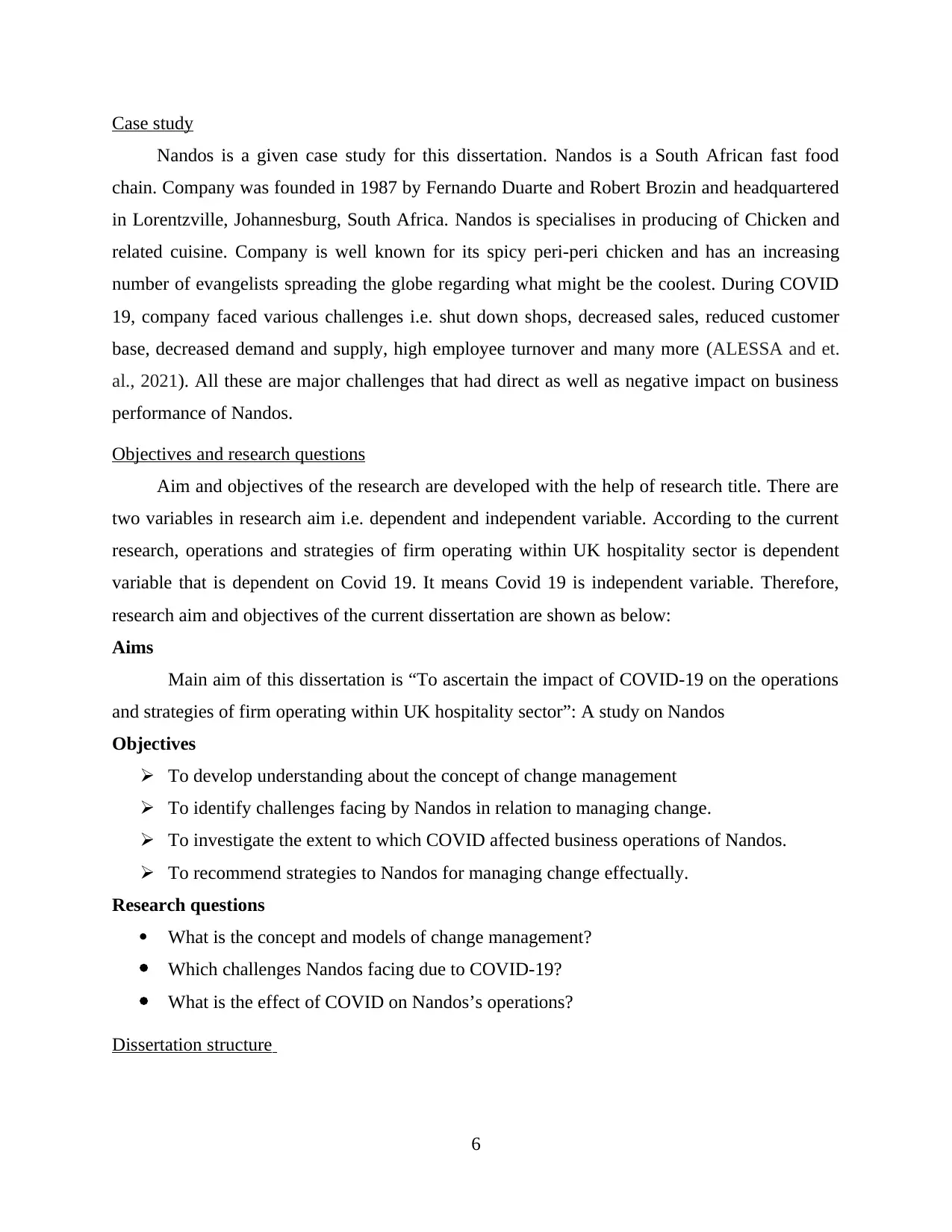
Case study
Nandos is a given case study for this dissertation. Nandos is a South African fast food
chain. Company was founded in 1987 by Fernando Duarte and Robert Brozin and headquartered
in Lorentzville, Johannesburg, South Africa. Nandos is specialises in producing of Chicken and
related cuisine. Company is well known for its spicy peri-peri chicken and has an increasing
number of evangelists spreading the globe regarding what might be the coolest. During COVID
19, company faced various challenges i.e. shut down shops, decreased sales, reduced customer
base, decreased demand and supply, high employee turnover and many more (ALESSA and et.
al., 2021). All these are major challenges that had direct as well as negative impact on business
performance of Nandos.
Objectives and research questions
Aim and objectives of the research are developed with the help of research title. There are
two variables in research aim i.e. dependent and independent variable. According to the current
research, operations and strategies of firm operating within UK hospitality sector is dependent
variable that is dependent on Covid 19. It means Covid 19 is independent variable. Therefore,
research aim and objectives of the current dissertation are shown as below:
Aims
Main aim of this dissertation is “To ascertain the impact of COVID-19 on the operations
and strategies of firm operating within UK hospitality sector”: A study on Nandos
Objectives
To develop understanding about the concept of change management
To identify challenges facing by Nandos in relation to managing change.
To investigate the extent to which COVID affected business operations of Nandos.
To recommend strategies to Nandos for managing change effectually.
Research questions
What is the concept and models of change management?
Which challenges Nandos facing due to COVID-19?
What is the effect of COVID on Nandos’s operations?
Dissertation structure
6
Nandos is a given case study for this dissertation. Nandos is a South African fast food
chain. Company was founded in 1987 by Fernando Duarte and Robert Brozin and headquartered
in Lorentzville, Johannesburg, South Africa. Nandos is specialises in producing of Chicken and
related cuisine. Company is well known for its spicy peri-peri chicken and has an increasing
number of evangelists spreading the globe regarding what might be the coolest. During COVID
19, company faced various challenges i.e. shut down shops, decreased sales, reduced customer
base, decreased demand and supply, high employee turnover and many more (ALESSA and et.
al., 2021). All these are major challenges that had direct as well as negative impact on business
performance of Nandos.
Objectives and research questions
Aim and objectives of the research are developed with the help of research title. There are
two variables in research aim i.e. dependent and independent variable. According to the current
research, operations and strategies of firm operating within UK hospitality sector is dependent
variable that is dependent on Covid 19. It means Covid 19 is independent variable. Therefore,
research aim and objectives of the current dissertation are shown as below:
Aims
Main aim of this dissertation is “To ascertain the impact of COVID-19 on the operations
and strategies of firm operating within UK hospitality sector”: A study on Nandos
Objectives
To develop understanding about the concept of change management
To identify challenges facing by Nandos in relation to managing change.
To investigate the extent to which COVID affected business operations of Nandos.
To recommend strategies to Nandos for managing change effectually.
Research questions
What is the concept and models of change management?
Which challenges Nandos facing due to COVID-19?
What is the effect of COVID on Nandos’s operations?
Dissertation structure
6
⊘ This is a preview!⊘
Do you want full access?
Subscribe today to unlock all pages.

Trusted by 1+ million students worldwide
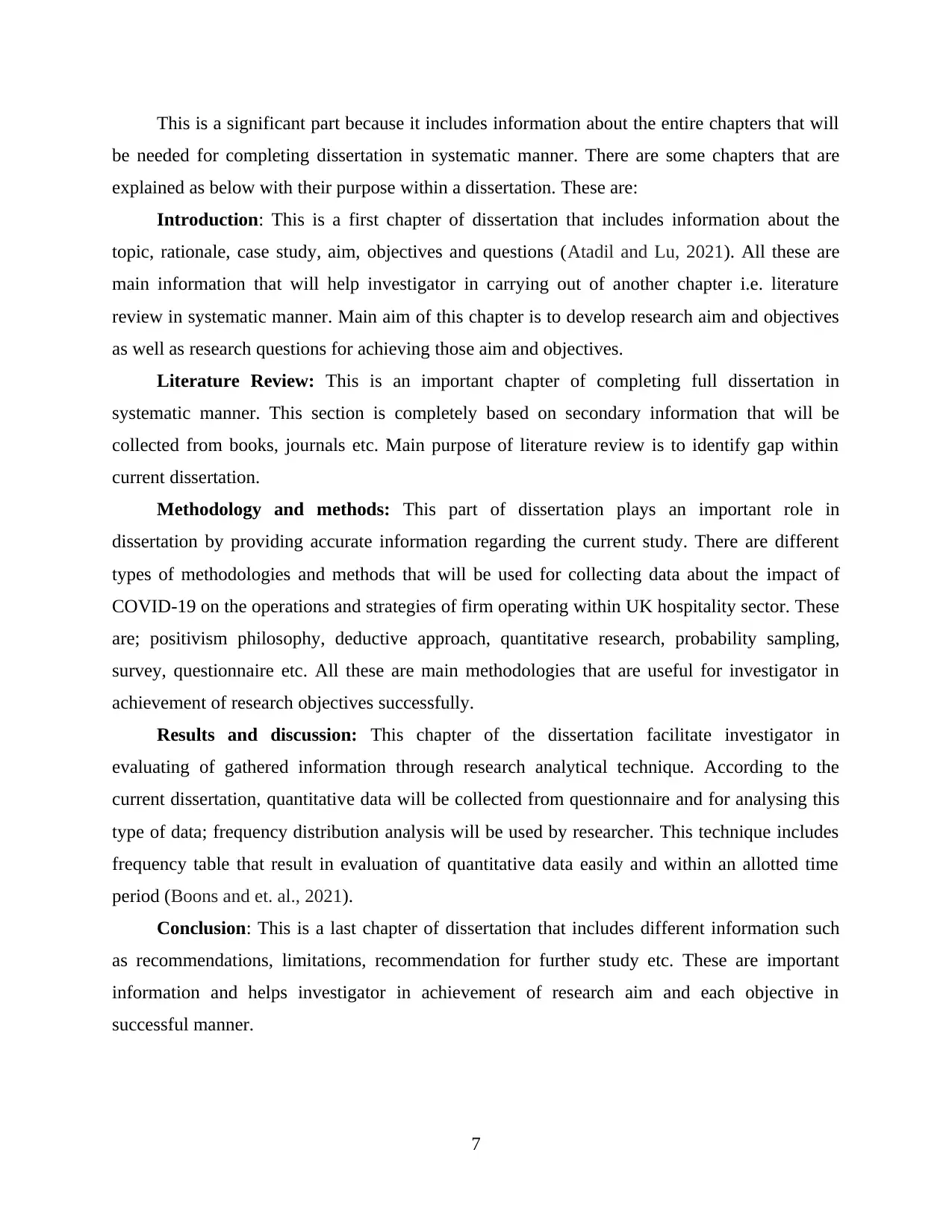
This is a significant part because it includes information about the entire chapters that will
be needed for completing dissertation in systematic manner. There are some chapters that are
explained as below with their purpose within a dissertation. These are:
Introduction: This is a first chapter of dissertation that includes information about the
topic, rationale, case study, aim, objectives and questions (Atadil and Lu, 2021). All these are
main information that will help investigator in carrying out of another chapter i.e. literature
review in systematic manner. Main aim of this chapter is to develop research aim and objectives
as well as research questions for achieving those aim and objectives.
Literature Review: This is an important chapter of completing full dissertation in
systematic manner. This section is completely based on secondary information that will be
collected from books, journals etc. Main purpose of literature review is to identify gap within
current dissertation.
Methodology and methods: This part of dissertation plays an important role in
dissertation by providing accurate information regarding the current study. There are different
types of methodologies and methods that will be used for collecting data about the impact of
COVID-19 on the operations and strategies of firm operating within UK hospitality sector. These
are; positivism philosophy, deductive approach, quantitative research, probability sampling,
survey, questionnaire etc. All these are main methodologies that are useful for investigator in
achievement of research objectives successfully.
Results and discussion: This chapter of the dissertation facilitate investigator in
evaluating of gathered information through research analytical technique. According to the
current dissertation, quantitative data will be collected from questionnaire and for analysing this
type of data; frequency distribution analysis will be used by researcher. This technique includes
frequency table that result in evaluation of quantitative data easily and within an allotted time
period (Boons and et. al., 2021).
Conclusion: This is a last chapter of dissertation that includes different information such
as recommendations, limitations, recommendation for further study etc. These are important
information and helps investigator in achievement of research aim and each objective in
successful manner.
7
be needed for completing dissertation in systematic manner. There are some chapters that are
explained as below with their purpose within a dissertation. These are:
Introduction: This is a first chapter of dissertation that includes information about the
topic, rationale, case study, aim, objectives and questions (Atadil and Lu, 2021). All these are
main information that will help investigator in carrying out of another chapter i.e. literature
review in systematic manner. Main aim of this chapter is to develop research aim and objectives
as well as research questions for achieving those aim and objectives.
Literature Review: This is an important chapter of completing full dissertation in
systematic manner. This section is completely based on secondary information that will be
collected from books, journals etc. Main purpose of literature review is to identify gap within
current dissertation.
Methodology and methods: This part of dissertation plays an important role in
dissertation by providing accurate information regarding the current study. There are different
types of methodologies and methods that will be used for collecting data about the impact of
COVID-19 on the operations and strategies of firm operating within UK hospitality sector. These
are; positivism philosophy, deductive approach, quantitative research, probability sampling,
survey, questionnaire etc. All these are main methodologies that are useful for investigator in
achievement of research objectives successfully.
Results and discussion: This chapter of the dissertation facilitate investigator in
evaluating of gathered information through research analytical technique. According to the
current dissertation, quantitative data will be collected from questionnaire and for analysing this
type of data; frequency distribution analysis will be used by researcher. This technique includes
frequency table that result in evaluation of quantitative data easily and within an allotted time
period (Boons and et. al., 2021).
Conclusion: This is a last chapter of dissertation that includes different information such
as recommendations, limitations, recommendation for further study etc. These are important
information and helps investigator in achievement of research aim and each objective in
successful manner.
7
Paraphrase This Document
Need a fresh take? Get an instant paraphrase of this document with our AI Paraphraser
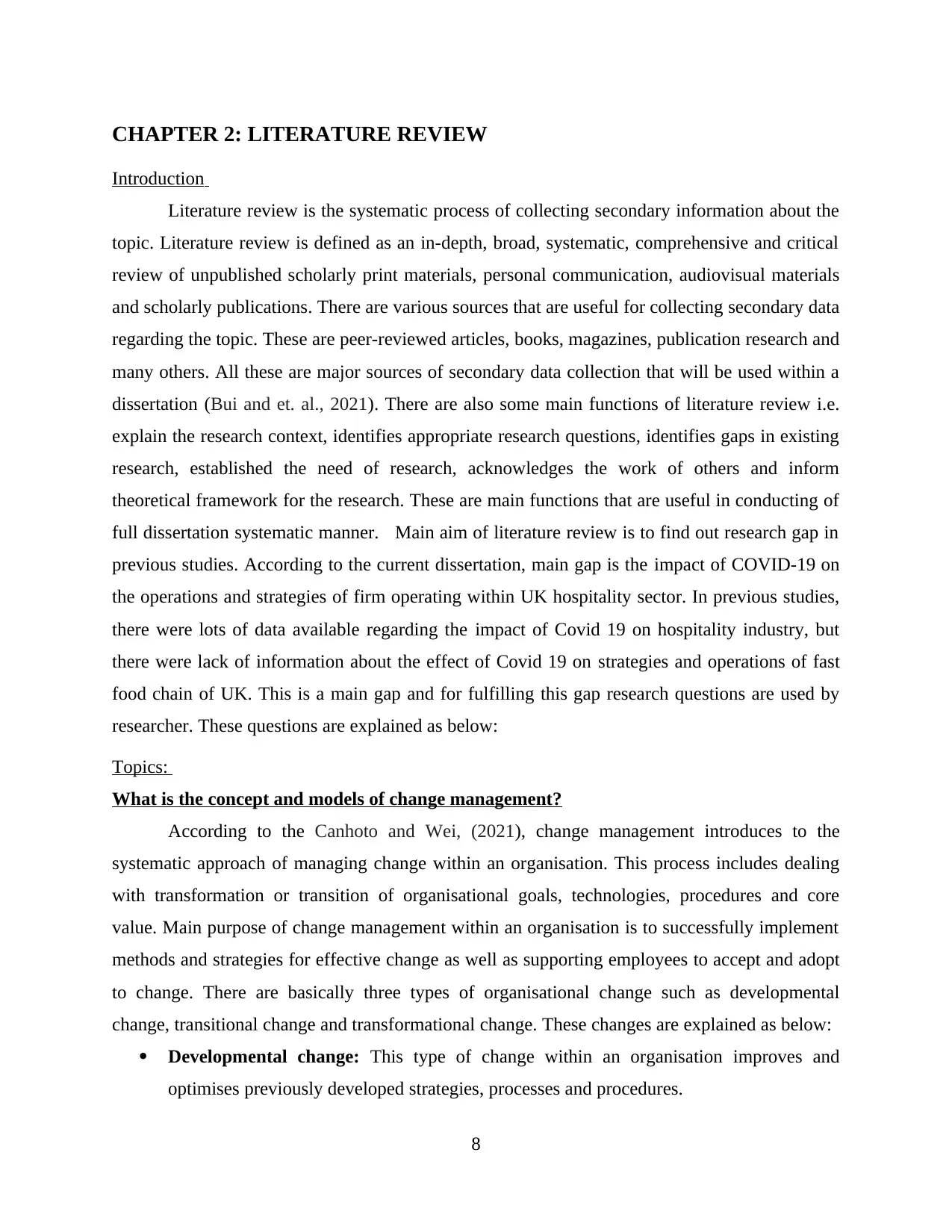
CHAPTER 2: LITERATURE REVIEW
Introduction
Literature review is the systematic process of collecting secondary information about the
topic. Literature review is defined as an in-depth, broad, systematic, comprehensive and critical
review of unpublished scholarly print materials, personal communication, audiovisual materials
and scholarly publications. There are various sources that are useful for collecting secondary data
regarding the topic. These are peer-reviewed articles, books, magazines, publication research and
many others. All these are major sources of secondary data collection that will be used within a
dissertation (Bui and et. al., 2021). There are also some main functions of literature review i.e.
explain the research context, identifies appropriate research questions, identifies gaps in existing
research, established the need of research, acknowledges the work of others and inform
theoretical framework for the research. These are main functions that are useful in conducting of
full dissertation systematic manner. Main aim of literature review is to find out research gap in
previous studies. According to the current dissertation, main gap is the impact of COVID-19 on
the operations and strategies of firm operating within UK hospitality sector. In previous studies,
there were lots of data available regarding the impact of Covid 19 on hospitality industry, but
there were lack of information about the effect of Covid 19 on strategies and operations of fast
food chain of UK. This is a main gap and for fulfilling this gap research questions are used by
researcher. These questions are explained as below:
Topics:
What is the concept and models of change management?
According to the Canhoto and Wei, (2021), change management introduces to the
systematic approach of managing change within an organisation. This process includes dealing
with transformation or transition of organisational goals, technologies, procedures and core
value. Main purpose of change management within an organisation is to successfully implement
methods and strategies for effective change as well as supporting employees to accept and adopt
to change. There are basically three types of organisational change such as developmental
change, transitional change and transformational change. These changes are explained as below:
Developmental change: This type of change within an organisation improves and
optimises previously developed strategies, processes and procedures.
8
Introduction
Literature review is the systematic process of collecting secondary information about the
topic. Literature review is defined as an in-depth, broad, systematic, comprehensive and critical
review of unpublished scholarly print materials, personal communication, audiovisual materials
and scholarly publications. There are various sources that are useful for collecting secondary data
regarding the topic. These are peer-reviewed articles, books, magazines, publication research and
many others. All these are major sources of secondary data collection that will be used within a
dissertation (Bui and et. al., 2021). There are also some main functions of literature review i.e.
explain the research context, identifies appropriate research questions, identifies gaps in existing
research, established the need of research, acknowledges the work of others and inform
theoretical framework for the research. These are main functions that are useful in conducting of
full dissertation systematic manner. Main aim of literature review is to find out research gap in
previous studies. According to the current dissertation, main gap is the impact of COVID-19 on
the operations and strategies of firm operating within UK hospitality sector. In previous studies,
there were lots of data available regarding the impact of Covid 19 on hospitality industry, but
there were lack of information about the effect of Covid 19 on strategies and operations of fast
food chain of UK. This is a main gap and for fulfilling this gap research questions are used by
researcher. These questions are explained as below:
Topics:
What is the concept and models of change management?
According to the Canhoto and Wei, (2021), change management introduces to the
systematic approach of managing change within an organisation. This process includes dealing
with transformation or transition of organisational goals, technologies, procedures and core
value. Main purpose of change management within an organisation is to successfully implement
methods and strategies for effective change as well as supporting employees to accept and adopt
to change. There are basically three types of organisational change such as developmental
change, transitional change and transformational change. These changes are explained as below:
Developmental change: This type of change within an organisation improves and
optimises previously developed strategies, processes and procedures.
8
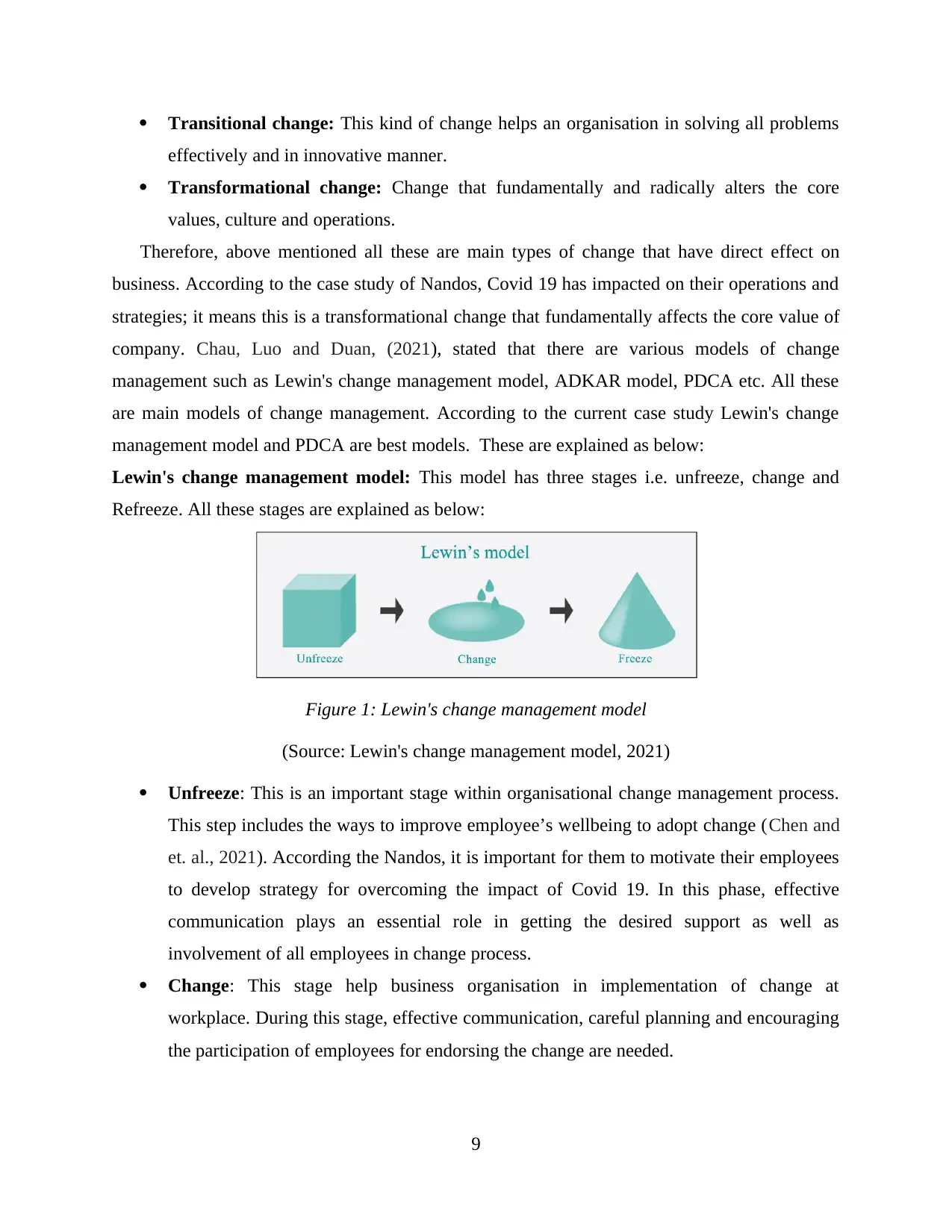
Transitional change: This kind of change helps an organisation in solving all problems
effectively and in innovative manner.
Transformational change: Change that fundamentally and radically alters the core
values, culture and operations.
Therefore, above mentioned all these are main types of change that have direct effect on
business. According to the case study of Nandos, Covid 19 has impacted on their operations and
strategies; it means this is a transformational change that fundamentally affects the core value of
company. Chau, Luo and Duan, (2021), stated that there are various models of change
management such as Lewin's change management model, ADKAR model, PDCA etc. All these
are main models of change management. According to the current case study Lewin's change
management model and PDCA are best models. These are explained as below:
Lewin's change management model: This model has three stages i.e. unfreeze, change and
Refreeze. All these stages are explained as below:
Figure 1: Lewin's change management model
(Source: Lewin's change management model, 2021)
Unfreeze: This is an important stage within organisational change management process.
This step includes the ways to improve employee’s wellbeing to adopt change (Chen and
et. al., 2021). According the Nandos, it is important for them to motivate their employees
to develop strategy for overcoming the impact of Covid 19. In this phase, effective
communication plays an essential role in getting the desired support as well as
involvement of all employees in change process.
Change: This stage help business organisation in implementation of change at
workplace. During this stage, effective communication, careful planning and encouraging
the participation of employees for endorsing the change are needed.
9
effectively and in innovative manner.
Transformational change: Change that fundamentally and radically alters the core
values, culture and operations.
Therefore, above mentioned all these are main types of change that have direct effect on
business. According to the case study of Nandos, Covid 19 has impacted on their operations and
strategies; it means this is a transformational change that fundamentally affects the core value of
company. Chau, Luo and Duan, (2021), stated that there are various models of change
management such as Lewin's change management model, ADKAR model, PDCA etc. All these
are main models of change management. According to the current case study Lewin's change
management model and PDCA are best models. These are explained as below:
Lewin's change management model: This model has three stages i.e. unfreeze, change and
Refreeze. All these stages are explained as below:
Figure 1: Lewin's change management model
(Source: Lewin's change management model, 2021)
Unfreeze: This is an important stage within organisational change management process.
This step includes the ways to improve employee’s wellbeing to adopt change (Chen and
et. al., 2021). According the Nandos, it is important for them to motivate their employees
to develop strategy for overcoming the impact of Covid 19. In this phase, effective
communication plays an essential role in getting the desired support as well as
involvement of all employees in change process.
Change: This stage help business organisation in implementation of change at
workplace. During this stage, effective communication, careful planning and encouraging
the participation of employees for endorsing the change are needed.
9
⊘ This is a preview!⊘
Do you want full access?
Subscribe today to unlock all pages.

Trusted by 1+ million students worldwide
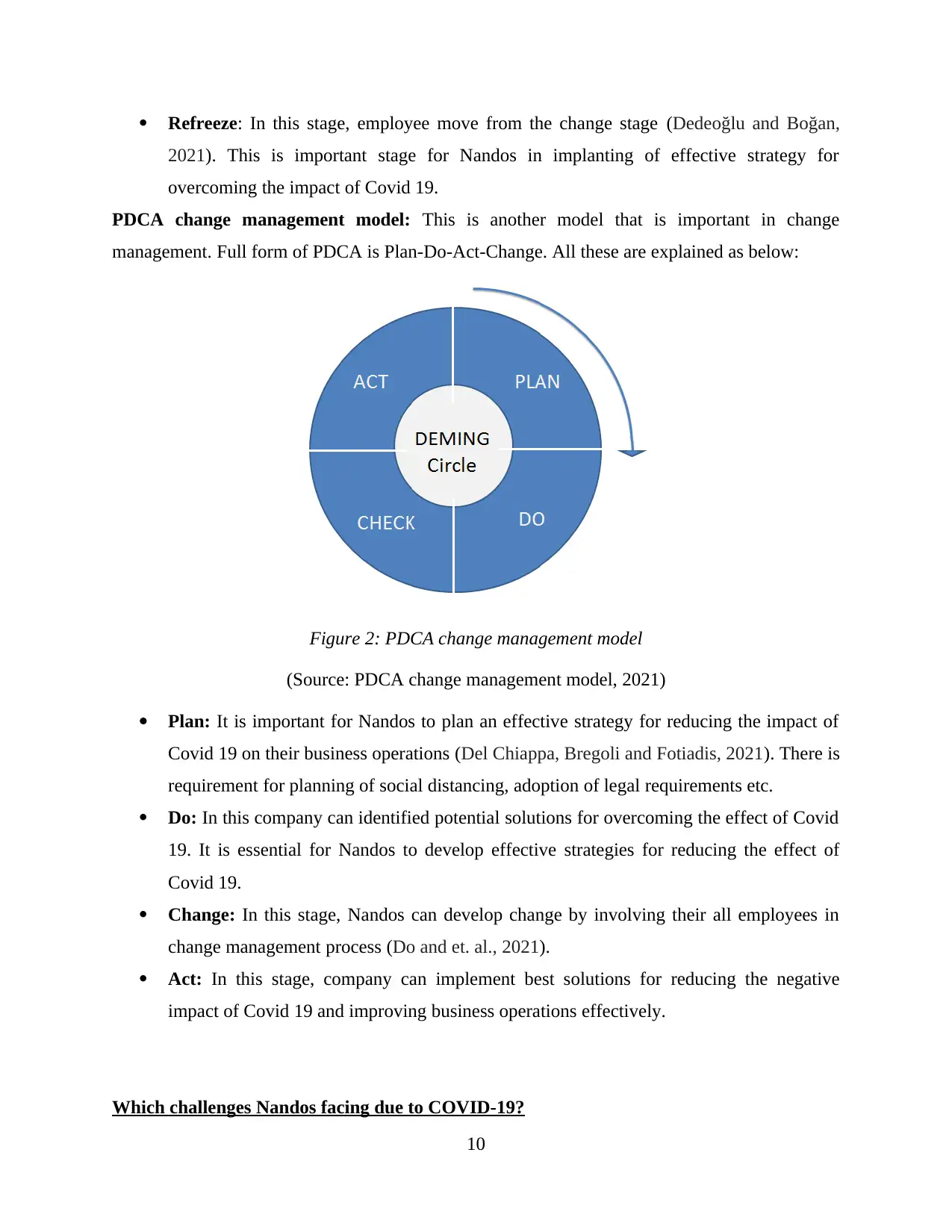
Refreeze: In this stage, employee move from the change stage (Dedeoğlu and Boğan,
2021). This is important stage for Nandos in implanting of effective strategy for
overcoming the impact of Covid 19.
PDCA change management model: This is another model that is important in change
management. Full form of PDCA is Plan-Do-Act-Change. All these are explained as below:
Figure 2: PDCA change management model
(Source: PDCA change management model, 2021)
Plan: It is important for Nandos to plan an effective strategy for reducing the impact of
Covid 19 on their business operations (Del Chiappa, Bregoli and Fotiadis, 2021). There is
requirement for planning of social distancing, adoption of legal requirements etc.
Do: In this company can identified potential solutions for overcoming the effect of Covid
19. It is essential for Nandos to develop effective strategies for reducing the effect of
Covid 19.
Change: In this stage, Nandos can develop change by involving their all employees in
change management process (Do and et. al., 2021).
Act: In this stage, company can implement best solutions for reducing the negative
impact of Covid 19 and improving business operations effectively.
Which challenges Nandos facing due to COVID-19?
10
2021). This is important stage for Nandos in implanting of effective strategy for
overcoming the impact of Covid 19.
PDCA change management model: This is another model that is important in change
management. Full form of PDCA is Plan-Do-Act-Change. All these are explained as below:
Figure 2: PDCA change management model
(Source: PDCA change management model, 2021)
Plan: It is important for Nandos to plan an effective strategy for reducing the impact of
Covid 19 on their business operations (Del Chiappa, Bregoli and Fotiadis, 2021). There is
requirement for planning of social distancing, adoption of legal requirements etc.
Do: In this company can identified potential solutions for overcoming the effect of Covid
19. It is essential for Nandos to develop effective strategies for reducing the effect of
Covid 19.
Change: In this stage, Nandos can develop change by involving their all employees in
change management process (Do and et. al., 2021).
Act: In this stage, company can implement best solutions for reducing the negative
impact of Covid 19 and improving business operations effectively.
Which challenges Nandos facing due to COVID-19?
10
Paraphrase This Document
Need a fresh take? Get an instant paraphrase of this document with our AI Paraphraser
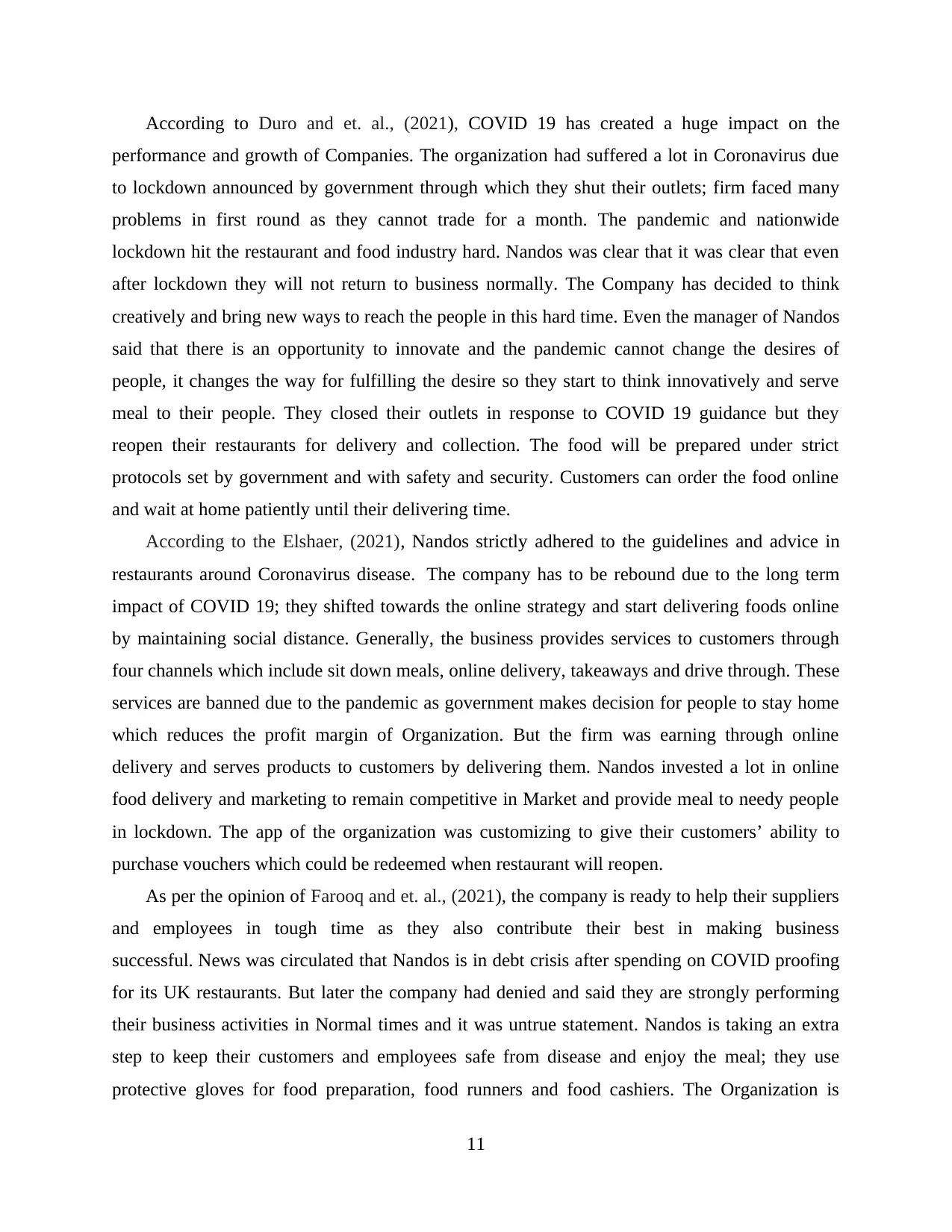
According to Duro and et. al., (2021), COVID 19 has created a huge impact on the
performance and growth of Companies. The organization had suffered a lot in Coronavirus due
to lockdown announced by government through which they shut their outlets; firm faced many
problems in first round as they cannot trade for a month. The pandemic and nationwide
lockdown hit the restaurant and food industry hard. Nandos was clear that it was clear that even
after lockdown they will not return to business normally. The Company has decided to think
creatively and bring new ways to reach the people in this hard time. Even the manager of Nandos
said that there is an opportunity to innovate and the pandemic cannot change the desires of
people, it changes the way for fulfilling the desire so they start to think innovatively and serve
meal to their people. They closed their outlets in response to COVID 19 guidance but they
reopen their restaurants for delivery and collection. The food will be prepared under strict
protocols set by government and with safety and security. Customers can order the food online
and wait at home patiently until their delivering time.
According to the Elshaer, (2021), Nandos strictly adhered to the guidelines and advice in
restaurants around Coronavirus disease. The company has to be rebound due to the long term
impact of COVID 19; they shifted towards the online strategy and start delivering foods online
by maintaining social distance. Generally, the business provides services to customers through
four channels which include sit down meals, online delivery, takeaways and drive through. These
services are banned due to the pandemic as government makes decision for people to stay home
which reduces the profit margin of Organization. But the firm was earning through online
delivery and serves products to customers by delivering them. Nandos invested a lot in online
food delivery and marketing to remain competitive in Market and provide meal to needy people
in lockdown. The app of the organization was customizing to give their customers’ ability to
purchase vouchers which could be redeemed when restaurant will reopen.
As per the opinion of Farooq and et. al., (2021), the company is ready to help their suppliers
and employees in tough time as they also contribute their best in making business
successful. News was circulated that Nandos is in debt crisis after spending on COVID proofing
for its UK restaurants. But later the company had denied and said they are strongly performing
their business activities in Normal times and it was untrue statement. Nandos is taking an extra
step to keep their customers and employees safe from disease and enjoy the meal; they use
protective gloves for food preparation, food runners and food cashiers. The Organization is
11
performance and growth of Companies. The organization had suffered a lot in Coronavirus due
to lockdown announced by government through which they shut their outlets; firm faced many
problems in first round as they cannot trade for a month. The pandemic and nationwide
lockdown hit the restaurant and food industry hard. Nandos was clear that it was clear that even
after lockdown they will not return to business normally. The Company has decided to think
creatively and bring new ways to reach the people in this hard time. Even the manager of Nandos
said that there is an opportunity to innovate and the pandemic cannot change the desires of
people, it changes the way for fulfilling the desire so they start to think innovatively and serve
meal to their people. They closed their outlets in response to COVID 19 guidance but they
reopen their restaurants for delivery and collection. The food will be prepared under strict
protocols set by government and with safety and security. Customers can order the food online
and wait at home patiently until their delivering time.
According to the Elshaer, (2021), Nandos strictly adhered to the guidelines and advice in
restaurants around Coronavirus disease. The company has to be rebound due to the long term
impact of COVID 19; they shifted towards the online strategy and start delivering foods online
by maintaining social distance. Generally, the business provides services to customers through
four channels which include sit down meals, online delivery, takeaways and drive through. These
services are banned due to the pandemic as government makes decision for people to stay home
which reduces the profit margin of Organization. But the firm was earning through online
delivery and serves products to customers by delivering them. Nandos invested a lot in online
food delivery and marketing to remain competitive in Market and provide meal to needy people
in lockdown. The app of the organization was customizing to give their customers’ ability to
purchase vouchers which could be redeemed when restaurant will reopen.
As per the opinion of Farooq and et. al., (2021), the company is ready to help their suppliers
and employees in tough time as they also contribute their best in making business
successful. News was circulated that Nandos is in debt crisis after spending on COVID proofing
for its UK restaurants. But later the company had denied and said they are strongly performing
their business activities in Normal times and it was untrue statement. Nandos is taking an extra
step to keep their customers and employees safe from disease and enjoy the meal; they use
protective gloves for food preparation, food runners and food cashiers. The Organization is
11
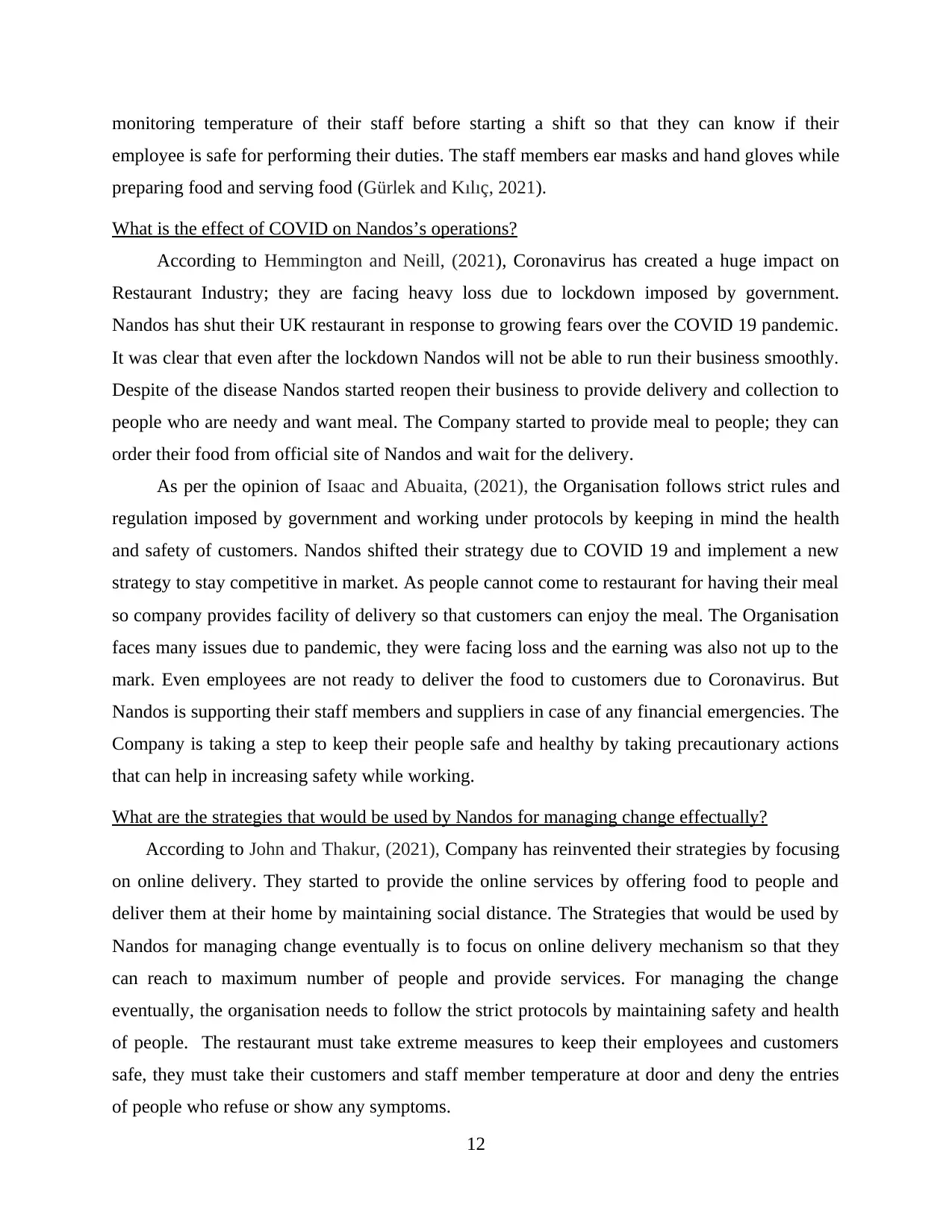
monitoring temperature of their staff before starting a shift so that they can know if their
employee is safe for performing their duties. The staff members ear masks and hand gloves while
preparing food and serving food (Gürlek and Kılıç, 2021).
What is the effect of COVID on Nandos’s operations?
According to Hemmington and Neill, (2021), Coronavirus has created a huge impact on
Restaurant Industry; they are facing heavy loss due to lockdown imposed by government.
Nandos has shut their UK restaurant in response to growing fears over the COVID 19 pandemic.
It was clear that even after the lockdown Nandos will not be able to run their business smoothly.
Despite of the disease Nandos started reopen their business to provide delivery and collection to
people who are needy and want meal. The Company started to provide meal to people; they can
order their food from official site of Nandos and wait for the delivery.
As per the opinion of Isaac and Abuaita, (2021), the Organisation follows strict rules and
regulation imposed by government and working under protocols by keeping in mind the health
and safety of customers. Nandos shifted their strategy due to COVID 19 and implement a new
strategy to stay competitive in market. As people cannot come to restaurant for having their meal
so company provides facility of delivery so that customers can enjoy the meal. The Organisation
faces many issues due to pandemic, they were facing loss and the earning was also not up to the
mark. Even employees are not ready to deliver the food to customers due to Coronavirus. But
Nandos is supporting their staff members and suppliers in case of any financial emergencies. The
Company is taking a step to keep their people safe and healthy by taking precautionary actions
that can help in increasing safety while working.
What are the strategies that would be used by Nandos for managing change effectually?
According to John and Thakur, (2021), Company has reinvented their strategies by focusing
on online delivery. They started to provide the online services by offering food to people and
deliver them at their home by maintaining social distance. The Strategies that would be used by
Nandos for managing change eventually is to focus on online delivery mechanism so that they
can reach to maximum number of people and provide services. For managing the change
eventually, the organisation needs to follow the strict protocols by maintaining safety and health
of people. The restaurant must take extreme measures to keep their employees and customers
safe, they must take their customers and staff member temperature at door and deny the entries
of people who refuse or show any symptoms.
12
employee is safe for performing their duties. The staff members ear masks and hand gloves while
preparing food and serving food (Gürlek and Kılıç, 2021).
What is the effect of COVID on Nandos’s operations?
According to Hemmington and Neill, (2021), Coronavirus has created a huge impact on
Restaurant Industry; they are facing heavy loss due to lockdown imposed by government.
Nandos has shut their UK restaurant in response to growing fears over the COVID 19 pandemic.
It was clear that even after the lockdown Nandos will not be able to run their business smoothly.
Despite of the disease Nandos started reopen their business to provide delivery and collection to
people who are needy and want meal. The Company started to provide meal to people; they can
order their food from official site of Nandos and wait for the delivery.
As per the opinion of Isaac and Abuaita, (2021), the Organisation follows strict rules and
regulation imposed by government and working under protocols by keeping in mind the health
and safety of customers. Nandos shifted their strategy due to COVID 19 and implement a new
strategy to stay competitive in market. As people cannot come to restaurant for having their meal
so company provides facility of delivery so that customers can enjoy the meal. The Organisation
faces many issues due to pandemic, they were facing loss and the earning was also not up to the
mark. Even employees are not ready to deliver the food to customers due to Coronavirus. But
Nandos is supporting their staff members and suppliers in case of any financial emergencies. The
Company is taking a step to keep their people safe and healthy by taking precautionary actions
that can help in increasing safety while working.
What are the strategies that would be used by Nandos for managing change effectually?
According to John and Thakur, (2021), Company has reinvented their strategies by focusing
on online delivery. They started to provide the online services by offering food to people and
deliver them at their home by maintaining social distance. The Strategies that would be used by
Nandos for managing change eventually is to focus on online delivery mechanism so that they
can reach to maximum number of people and provide services. For managing the change
eventually, the organisation needs to follow the strict protocols by maintaining safety and health
of people. The restaurant must take extreme measures to keep their employees and customers
safe, they must take their customers and staff member temperature at door and deny the entries
of people who refuse or show any symptoms.
12
⊘ This is a preview!⊘
Do you want full access?
Subscribe today to unlock all pages.

Trusted by 1+ million students worldwide
1 out of 49
Related Documents
Your All-in-One AI-Powered Toolkit for Academic Success.
+13062052269
info@desklib.com
Available 24*7 on WhatsApp / Email
![[object Object]](/_next/static/media/star-bottom.7253800d.svg)
Unlock your academic potential
Copyright © 2020–2025 A2Z Services. All Rights Reserved. Developed and managed by ZUCOL.





